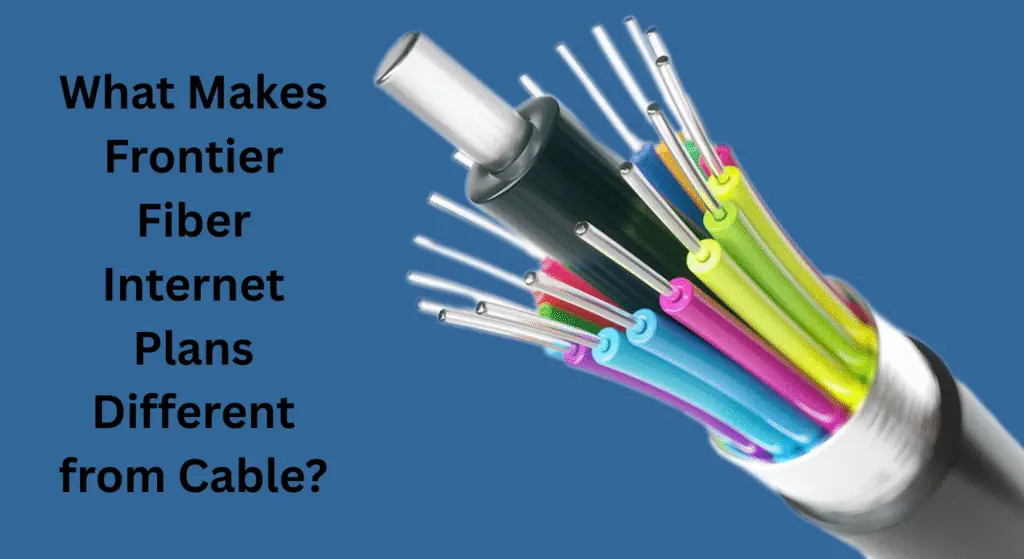The choice between fiber and cable internet affects more than the monthly cost; it determines how reliably your home or business can stay connected during high-demand tasks like streaming, video conferencing, and smart home automation. While many providers continue to offer cable as a standard, Frontier Fiber Internet Plans represent a more advanced and capable solution. As an experienced Internet Service Provider, Internet Bundle Now outlines the actual differences between fiber and cable, showing why more households are moving toward fiber-based services for long-term internet reliability.
The Infrastructure Behind Frontier Fiber Internet
Frontier Fiber Internet Plans are built on fiber-optic technology, which uses glass strands to transmit data via light signals. Unlike cable lines that carry electrical signals through copper coaxial wires, fiber-optic cables deliver higher bandwidth without degradation over distance. The system is engineered to send large volumes of data at high speeds directly to the user’s premises, with minimal loss. The Frontier network uses a fiber-to-the-home model, ensuring that the fiber signal does not switch to copper or coax at any point before reaching your equipment. This direct delivery model is one of the most important technical distinctions that sets fiber apart from traditional cable services.
Understanding the Limitations of Cable Internet
Cable internet relies on an older infrastructure originally designed for television signals. These coaxial cables still perform adequately for average data consumption but begin to falter under stress. In most cases, cable internet is delivered through a shared connection,n meaning your speeds are affected by how many people in your neighborhood are online at the same time. Download speeds may be decent, but upload speeds remain limited due to the network’s asymmetric design. Unlike fiber, which provides dedicated connections, cable systems often result in fluctuating speeds, particularly during evening hours or weekends when more users are online.
Comparing Speed Performance Between Fiber and Cable
Frontier Fiber Internet Plans are known for offering symmetrical speeds, meaning upload and download speeds are equal. This is essential for modern internet activities such as cloud file transfers, remote work, live streaming, and online collaboration. Cable internet, by contrast, typically offers much lower upload speeds, making it inefficient for users who need to send large files, conduct video meetings, or broadcast live video. Speed consistency is another factor that fiber maintains performance levels regardless of the time of day or the number of users in the area. Internet Bundle Now helps users understand their bandwidth needs and ensures they are matched with a plan that delivers consistent, real-world speed, not just advertised maximums.
Reliability Under Real Usage Conditions
Fiber networks are less prone to interference from environmental conditions such as moisture, electromagnetic interference, or heat. This results in fewer disruptions and lower latency, especially during peak traffic hours. Cable, however, can experience significant performance drops when more users are active in the area or when infrastructure maintenance is delayed. With Frontier Fiber Internet Plans, reliability is a foundational feature, not a marketing term. The network’s architecture is designed for always-on connectivity, making it suitable for homes and businesses where interruption is not an option. Internet Bundle Now delivers this infrastructure with the support needed to keep systems stable and performance predictable.
Bandwidth Capacity and Device Scalability
Households today run multiple smart TVs, streaming devices, gaming consoles, home security systems, and smart appliances, all of which depend on consistent bandwidth. Fiber’s higher bandwidth capacity allows dozens of devices to operate without sacrificing performance. Cable, limited by its shared infrastructure and coaxial design, struggles to maintain the same performance when usage scales up. With Frontier Fiber Internet Plans, users don’t need to ration bandwidth or limit device usage. This is especially relevant for families, small offices, and remote workers using multiple cloud-based tools simultaneously. As an experienced Internet Service Provider, Internet Bundle Now configures networks that grow with your digital demands.
Installation Differences That Affect Long-Term Use
Fiber installation involves the placement of an Optical Network Terminal (ONT) at the user’s location, which serves as the link between the fiber line and home devices. This is a permanent and scalable installation designed to handle future upgrades without replacing core components. Cable systems use modems connected to coaxial inputs, which often require frequent replacement to support speed increases. With Frontier Fiber Internet Plans, Internet Bundle Now ensures a one-time, future-ready setup that reduces the need for ongoing equipment updates and minimizes technical disruptions over time.
Data Policies and Network Congestion Impacts
A major advantage of Frontier Fiber Internet Plans is the absence of data caps. Users are free to consume bandwidth without penalties, regardless of how much data is uploaded or downloaded. Cable internet providers may enforce soft or hard data caps, leading to throttled speeds or extra charges once thresholds are exceeded. Congestion is another critical issue. Since cable operates on shared infrastructure, users often experience slowdowns during busy hours. Fiber networks, by contrast, maintain consistent speeds even when multiple households are active. At Internet Bundle Now, we ensure that customers are fully informed about how these policies affect their actual usage and billing.
Customer Service Support Throughout the Service Lifecycle
High-quality internet is not just about technology; it also depends on responsive and knowledgeable support. Frontier Customer Service, when accessed through Internet Bundle Now, provides structured assistance from installation to troubleshooting. Our customers receive guided onboarding, system optimization advice, and direct access to service resolution channels. While cable providers may rely on outsourced or inconsistent support teams, fiber installations handled through Internet Bundle Now come with localized and escalated assistance, ensuring that issues are addressed quickly and efficiently. Service quality is not an afterthought; it’s part of the product we deliver with every activation.
Ideal Users Who Benefit Most from Frontier Fiber
Not every internet user requires fiber, but for those managing high volumes of streaming, cloud data, virtual collaboration, or multiple smart devices, fiber is the right fit. Frontier Fiber Internet Plans are particularly suited for users who demand symmetrical upload and download speeds, live in homes with multiple connected devices, or rely on remote work tools that require low latency. Internet Bundle Now matches users with plans based on lifestyle, home layout, and future technology adoption, ensuring that they aren’t simply upgrading speeds but improving their entire digital experience.
Final Thought
The choice between cable and fiber isn’t simply about Mbps or monthly rates, it’s about performance consistency, reliability under pressure, and a future-ready network that won’t require constant upgrades. Frontier Fiber Internet Plans outperform cable in every major metric: from symmetrical speed to signal reliability, from equipment scalability to long-term value. As a trusted Internet Service Provider, Internet Bundle Now not only helps customers access fiber, they ensures the experience is tailored, supported, and optimized from day one. With growing internet demands across every household, the case for switching to fiber is no longer a question of if but when.


